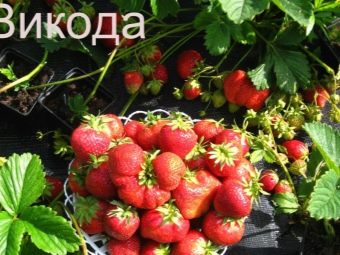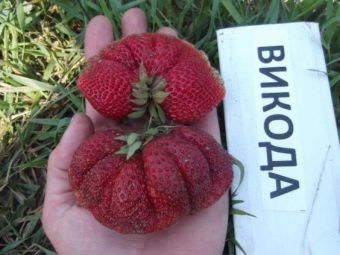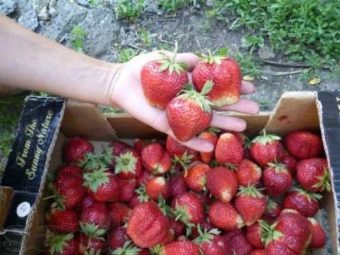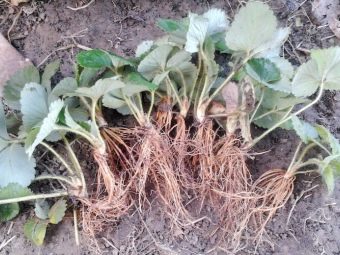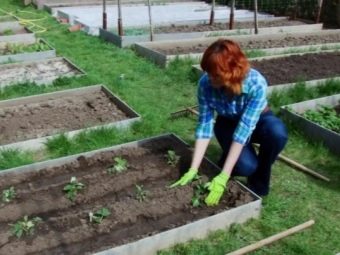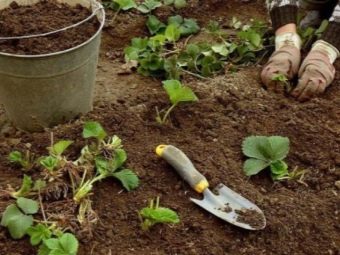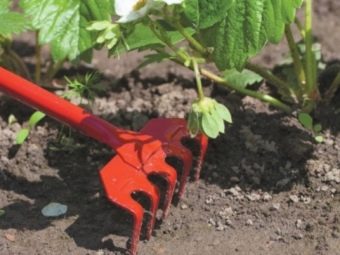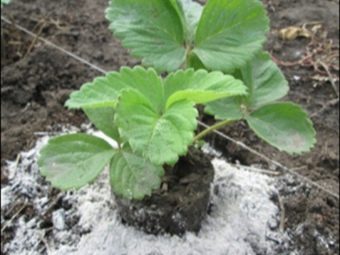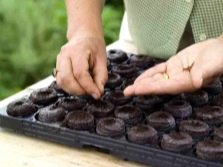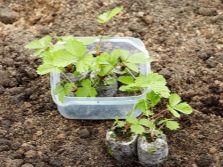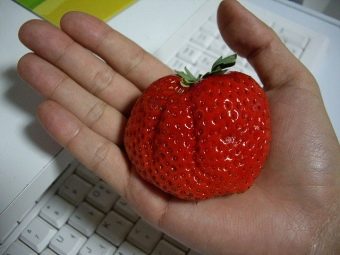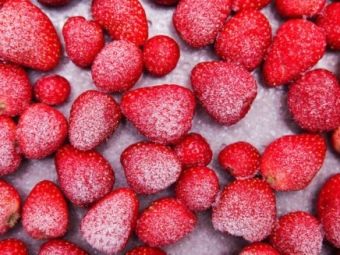Technology cultivation varieties of strawberries "Vicoda"
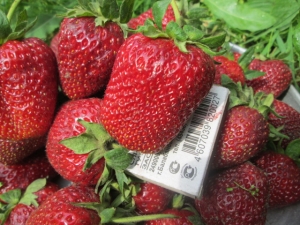
The strawberry variety “Vicoda” usually receives only positive reviews from gardeners.Although the amount of the crop is not very outstanding, it is quite enough to meet the needs of the family farm. The taste of berries is at a high level, as well as their appearance.
Culture does not require special care and easily cope with adverse weather phenomena.
Characteristic variety
Garden strawberries "Vicoda" was bred in Holland. Description of the variety suggests that the bushes are formed quite powerful, but small height. Large sheets have a beautiful bright shade. Their shape includes cloves and curly "ribs". Whiskers in this variety is formed a little, which, of course, makes the process of care for the culture easier. Petioles are covered with fine feathers.
The weight of one fruit varies from fifty to seventy grams, but at the first harvest it can even reach one hundred and twenty grams. The berries themselves are rather large, of traditional shape, bright red. The flesh is thick and pleasant to the taste, without voids. The taste is sweet, but sour, and the aftertaste "gives" cherry.
Matures "Vicoda" by about mid-July, which makes this variety late. However, for some gardeners this is a big plus, because the berry has ripen when all other varieties are already producing fruit. The first fruits appear quite large, and sometimes even double (in the form of crests). In the following years, the shape of the berries becomes normal. The whitened tip indicates that the strawberries have reached their technical maturity. From one bush the gardener usually collects about 1 kilogram of ripe fruits.
"Vicoda" seamlessly transfers freight. At the same time neither appearance of fruits, nor their tastes at all worsen. This variety is not afraid of temperature fluctuations, including the cold, inherent in the winter months. Strawberry adequately copes with the most common diseases. It is used both fresh and frozen. Also, the fruits are suitable for various blanks.
However, this type of culture has some drawbacks. For example, too high a temperature causes the density of the berries to decrease. In addition, the large size of the bushes require large areas, as between individual plants must be maintained proper distance.
Landing
For the "Vicoda" is to provide an area that will be well lit, but at the same time will not suffer from piercing winds. It is better to give preference to loamy soils or chernozem. Clay should be avoided. The condition of groundwater is also to be monitored - they should not be closer than sixty to eighty centimeters to the surface.
Speaking of predecessors, experts recommend choosing onions, garlic, marigolds or petunia. At the same place culture can grow from three to four years. Then it is better to provide a new “place of residence”.
Preparation begins in the fall. It was then that the selected area is cleared of weeds, remnants of roots and other debris. At the same time, fertilizers are also applied (as a rule, they are organic). If planting is done in the summer or autumn months, then the soil begins to be prepared thirty days before. It is important that the land has enough time to settle, otherwise the roots will be on the surface. In this case, the strawberries will not be able to grow properly.
An important role is played by the selection of seedlings. They must be persistent, healthy, and also have at least three sheets and a kidney on top. In addition, at this point there should be a root neck with a diameter greater than six millimeters, and roots, whose length should be more than seven centimeters. A few days before planting, the seedlings should be kept in a room with a low temperature so that the culture can then quickly adapt to weather conditions.
If the side roots are poorly developed, then it makes sense to shorten their length by five centimeters.
The landing takes place either in the first spring months, when the snow has already melted, and the ground has time to warm up, or at the junction of August and September. And in fact, and in another case, it is important that the danger of frost is over. So the seedlings will have the opportunity to adapt to the conditions, strengthen the root system and take root in a new place. Usually landing is carried out either on a cloudy day, or at the time of day when the sun is inactive. If the weather is too sunny, then the first fourteen days of the berries will need to be artificially darkened.
The holes are formed in such a way that the length of the rows between rows is from fifty to sixty centimeters, and the bushes themselves are separated from each other by an interval of forty centimeters. If you make the distance smaller, the plants, growing and increasing in size, will begin to interfere with each other.
Liquid is poured into each well, after which a seedling is dropped into it. The root must be straightened and priporoshit soil so that the "heart" does not go underground. After that, the land is slapped and irrigated. As a final step, it is recommended to carry out mulching, for example, with humus. Harvest can be collected a year after disembarkation.
Care
Caring for strawberries "Vicoda" is quite traditional. Watering should be carried out regularly and in the required quantities. Spring irrigation occurs once every week. When flowers and fruits appear, the amount of watering increases to three times in seven days. Finally, in the fall, the beds are watered twice a week until the cold begins. The ideal is considered to be drip irrigation system, allowing also to make liquid fertilizer. Sprinkling is also suitable. In addition, hydration is accompanied by mulching with straw or film. This procedure retains moisture in the soil.
Of course, such a procedure as weeding is important. It is better to tear out the weeds with bare hands and always with a spine. Of course, culture needs constant feeding with mineral compounds and organic matter. It is especially important to fertilize in the spring when there is an active growth and development of bushes. Before the winter season, the culture is wrapped with sawdust and straw. Be sure to check the roots. If they are close to the surface, they should be covered with earth. Also eliminated dried leaves and twigs.
Diseases and pests
Strawberries “Vicoda” should be regularly inspected, so that in case of unexpected symptoms immediately take action. Gray rot is determined by brown spots with feathers on sheets and berries. In this case, the damaged parts of the plant are immediately removed and discarded, and the plantings themselves are treated with fungicides. As a preventive measure, it is advisable to eliminate dead leaves in time, pluck weeds and mulch the gaps between rows with needles or straw.
The correct solution would be to powder the wet earth and the plants themselves with wood ash. If the "Vicod" was struck by powdery mildew, then you can guess about this by noticing a gradually darkening white bloom. In this case, the strawberries are immediately processed with fungicides. Prophylactic procedures include timely weeding and thinning of bushes.
The main pest interfering with the development of culture is the nematode. In the event of a kidney disease, wither, the thickness of the plates increases, the development of culture is inhibited. To destroy the insect is possible only with the help of chemicals. The same applies to the strawberry mite, which feeds on young leaves, which leads to their deformation.
In both cases, preventive measures are required: proper care, compliance with the rules of crop rotation, thinning the beds and planting "neighbors" that produce fungicides (for example, marigolds).
Breeding
It is customary to propagate “Vicodu” by whiskers, seeds, or by dividing a bush. Seed material, by the way, is not particularly welcome, since its use threatens with the appearance of small and savory fruits.The use of whiskers is the most common way. The division of the bush is also quite effective. It is carried out by using healthy plants that have more than one top with a rosette.
Gardeners reviews
Judging by the words of summer residents, “Vicoda” is distinguished by very large fruits with a sugary, juicy pulp without voids and a delicate aroma with cherry notes. The size of the berries allows you to place on the palm from three to four strawberries. The yield of the variety is average (approximately from 700 to 800 grams of fruits from one bush).
With transportation, the variety copes satisfactorily, but it perfectly endures winters with low temperature - only leaf covering is enough. At the same time, after the frosts, the leaves remain fresh, bright green. Diseases of culture occur, but quite rarely.
The dressings are fairly traditional: organic fertilizers are introduced in the spring, and mineral solutions in the fall. In the summer, this procedure can be waived altogether. Most often, the "Vicoda" is used fresh, and is also used for freezing and boiling jam. In the latter case, the berries do not boil soft, but remain whole and neat.
For information on how to care for strawberries in spring, summer and autumn, see the following video.

